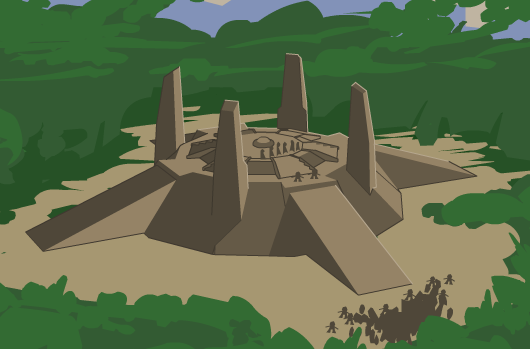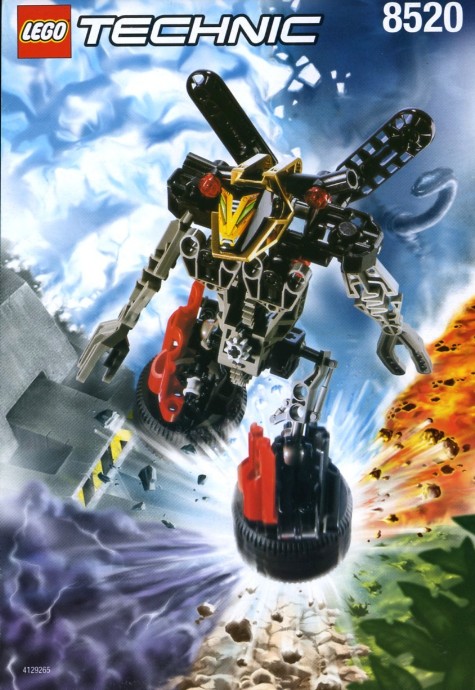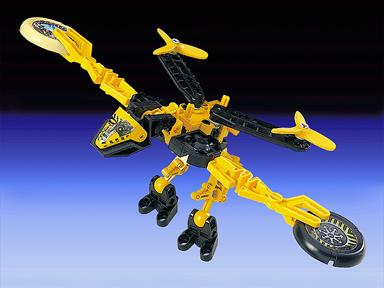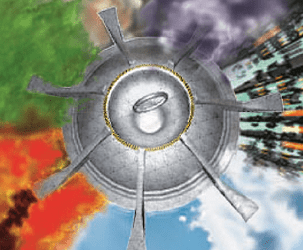These are some mostly-unorganized thoughts I have been developing about the ways in which the design of the Slizer theme informed the design of BIONICLE. I have been super enamored with Slizer as of late, and I think a big part of its allure is its status as almost an “alternate universe” version of BIONICLE, which we can see because it exists in our world. As I thought about this, I noted some really interesting similarities between them - which makes sense, considering the things that truly connect them at their basest level; they’re both ball-and-socket constructible action figure toy lines created by the LEGO Group around the turn of the millennium. When I talk about their similarities, I mean their narrative and thematic similarities.
One of the central similarities between Slizer and BIONICLE is that they revolve around a cast of color-coded, elementally-aligned characters who inhabit a world more-or-less inexplicably divided evenly into elementally-themed sectors. There’s a key difference, though, which is that BIONICLE has six elemental characters and Slizer features eight. Additionally, the world of the Slizers is divided into seven sectors, with the eighth Slizer occupying a special area (more on them later). This central area, though, appears in both BIONICLE and Slizer - it is elementally-neutral, and is a place that the various elemental figures convene to meet one another. Also, they look similar:

Each of the individual elemental beings travels throughout their elementally-themed world in search of a special object that will grant them power. For BIONICLE, this is the Kanohi, and later Golden Kanohi. For Slizer, this is relayed in the disk art - across the six story disks in each Slizer’s collection, we see the Slizer track down a special object to increase their power. The example below is City Slizer’s disks, showing it traversing the city, encountering a foe (in the form of a giant evil truck), and collecting a special fuel.
Each of the regions also has a unique symbol representing it, which can be seen as the “#2 disk” in each set. Note the 8 pips on the side of the disk - I consider the recurrence of the number eight here akin to the way 3 and 6 show up throughout BIONICLE lore. There’s very little story material for Slizer so this is really the only chance that 8 has to show up in any place other than the number of Slizers.
Also note on City Slizer’s #4 disk the rectangular craft shown flying through the city. Each of the Slizers has one of these, and it’s actually the packaging that the set came in, just like the Toa canisters. Similarly, both the Toa canisters and the Slizers’ ships have methods of storing collectibles - the lids on the Toa canisters become suva for masks, and the Slizer ships have storage racks for disks.
There’s a few more minor similarities of note. One of the things that distinguish some of the Slizers are their face plates - specially-printed parts with unique patterns for the faces of Amazon, Torch, Scuba, Jet, and later Millennia, Spark, Flare, and Blaster. In my opinion, this concept evolved into the unique molded masks of the Toa in BIONICLE. Similarly, Slizer’s second wave involved a meteor crashing into the Slizer planet, causing mutations in the evil Slizers, powering them up (this can be evidenced in the face plate design of one of the theme’s “titan” sets, Blaster, whose face plate is a meld of Amazon and Jet’s faceplates). I consider this analogous to the common trope of BIONICLE characters being mutated into new forms.
The biggest two points that I thought were interesting about these two themes’ shared DNA were two analogous characters. The first one that I think doesn’t need much explanation is Millennia, the Millennium Slizer, who is pretty obviously the theme’s Takanuva analogue.

Millennia is a special new Slizer with a golden piece near the face, who rides on a bike-like vehicle. I think the parallels are pretty obvious. Takanuva wears a golden Kanohi; Millennia’s head is golden (and uniquely so). Depending on your interpretation, he also could have come to help fight the big bad, just like Takanuva does in 2003 in the battle against Makuta (of course, the little existing story material is unclear on Millennia’s role, his motivations, and his alignment).
The other analogous character, which is both a longshot sort of theory but also well-supported, is that of Jet, the Judge Slizer.

As alluded to above, Jet is the Slizer who resides in the eighth, central, special, elementally-neutral area of the Slizer planet: the Judge Dome, the place where Slizers of disparate elements come together to settle disputes in a contest of disk-throwing skill. So, considering his name and place of residence, if Jet is intended to be the impartial judge of these contests, why is he always sorted into the “evil” Slizer lineup? All extant sources (read: LEGO Mania Magazine) agree that he, along with Amazon, Granite, and Electro, is an evil Slizer. In my opinion, this, along with the fact that he resides in the elementally-neutral area, makes him analogous to the character of Makuta. He is the “betrayer” archetype of the theme.
So, all of that is to say that BIONICLE clearly took some of the ideas that worked well with Slizer and adapted them into its own story and design, which is a no-brainer. They were designed for similar toys, around the same time, by the same company, and likely with many of the same people in charge. And some of this is just toy design, too. One of the easiest ways to differentiate a range of toys for kids to collect is to color-code them, and a good way to incorporate that color-coding into the story is elemental theming. Overall, though, I don’t really have a thesis; I just wanted to shed some light on this really interesting theme that not many people seem to talk about! Thanks for reading!

